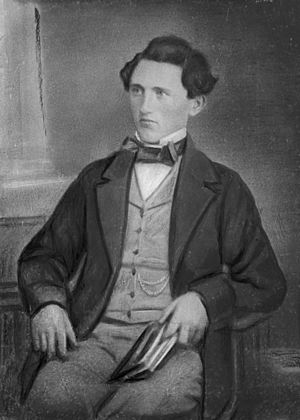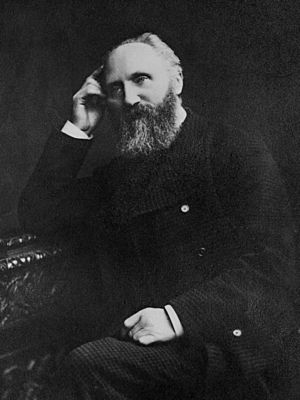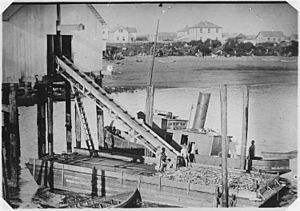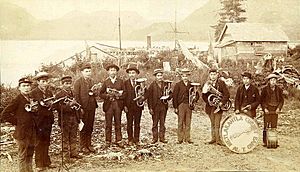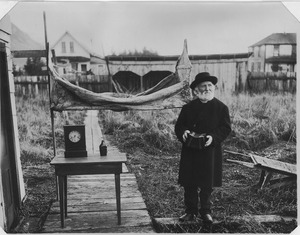William Duncan (missionary) facts for kids
William Duncan (born April 3, 1832 – died August 30, 1918) was an English missionary. He founded two important Tsimshian communities. These were Metlakatla, British Columbia, in Canada, and Metlakatla, Alaska, in the United States. Even though some called him "Father Duncan," he was never officially a priest.
Contents
Early Life and Training
Duncan was born in a small village called Bishop Burton in England. He was raised by his grandparents. In his early life, he worked as a book-keeper and later as a tanner. He was the only person in his family who regularly went to church.
In 1854, he joined the Church Mission Society (CMS). This group trained him to become a missionary.
Journey to Canada
In 1856, the CMS sent William Duncan to the North Pacific coast of Canada. He arrived in 1857 at a place called Lax Kw'alaams, British Columbia. This was a trading post run by the Hudson's Bay Company.
Duncan worked with the Tsimshian people there. He learned to speak their language from Arthur Wellington Clah. Clah was a Tsimshian leader and also worked for the Hudson's Bay Company. Clah even saved Duncan's life once. A powerful chief named Paul Legaic threatened Duncan. But Legaic later became one of Duncan's most important followers.
Building Metlakatla in British Columbia
Duncan wanted to create a new, safe community for his followers. He led about 60 Tsimshian people to start a new Christian village. They called it Metlakatla. It was located near what is now Prince Rupert, British Columbia. He wanted to protect his followers from the unhealthy influences of the trading post.
By the end of 1862, hundreds more people joined the community. Metlakatla officially began that year. In 1862, a serious smallpox sickness spread. It killed 500 people in Lax Kw'alaams. But only five people died in Metlakatla. Duncan believed this was a sign of divine protection for his community.
The community continued to grow and thrive.
Duncan's Rules for Living
William Duncan had strict rules for people living in Metlakatla. These rules helped guide the community in a Christian way of life. They were:
- To stop their traditional spiritual practices.
- To stop calling in traditional healers when sick.
- To stop gambling.
- To stop giving away property for show (like in the potlatch ceremony).
- To stop painting their faces.
- To stop drinking alcohol.
- To rest on Sundays.
- To attend religious lessons.
- To send their children to school.
- To be clean.
- To work hard.
- To be peaceful.
- To be fair and honest in trade.
- To build nice houses.
- To pay the village tax.
Starting "New" Metlakatla in Alaska
Duncan had disagreements with the Church of England. He wanted complete control over his community members' lives. Because of these differences, he was removed from the Church Missionary Society in 1881. He then changed his mission into an "Independent Native Church."
Eventually, he decided to start a second community. This new place would be on Annette Island in Alaska. He got permission from the U.S. government for this. In 1887, he led about 800 Tsimshian people. They traveled by canoe from "Old" Metlakatla to "New" Metlakatla, Alaska.
The new community in Alaska became very successful. It had a sawmill, a fish cannery, and other businesses. Duncan believed that the community should be able to support itself.
Challenges with Other Leaders
Later, some people in the community disagreed with Duncan. One leader was Reverend Edward Marsden. He led some Tsimshians to join the Presbyterian church. Marsden also worked to have Duncan removed from his position. He felt Duncan had too much power. He also believed Duncan was against Native people getting more education or economic freedom if it meant they would be outside his control.
Duncan also had disagreements with another missionary, Robert Tomlinson. Tomlinson had worked with Duncan before. But he left Metlakatla, Alaska, because he was unhappy with how Duncan was running things.
Death and Lasting Impact
William Duncan passed away on August 30, 1918. He was 86 years old. He died in "New" Metlakatla, Alaska, after a long illness.
Today, William Duncan is still a very talked-about person in Tsimshian communities. Many people admire him greatly for his work. Others strongly disagree with his methods and actions.



